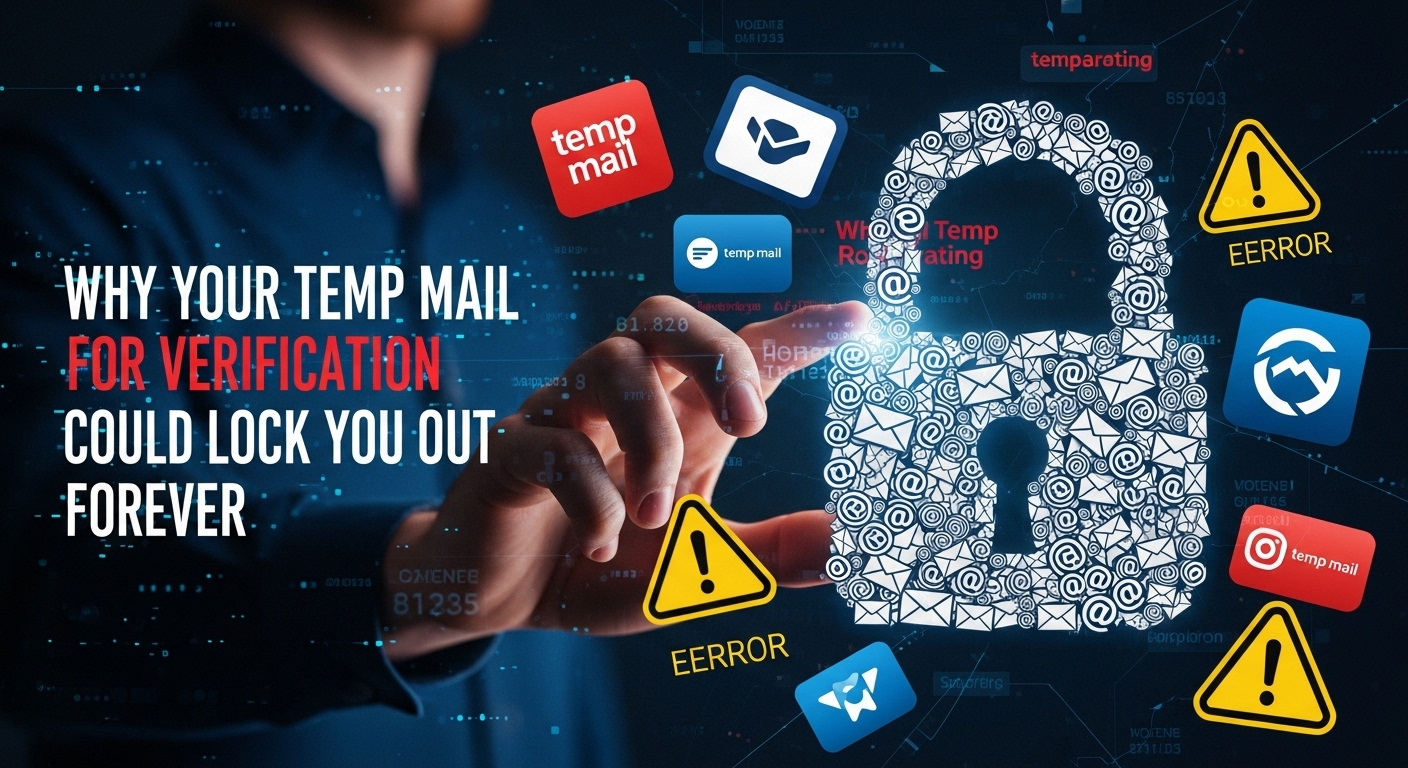Why Your Temp Mail for Verification Could Lock You Out Forever

Your email inbox used to be a simple tool. Now, it’s the master key to your entire digital life. It’s how you log into social media, access your bank, and track your online purchases. But this convenience comes with a hidden cost. Your inbox has become a battleground, and you’re under constant attack.
Think about it: nearly half of all email traffic worldwide is just spam. But it’s not just annoying junk mail. It’s a relentless wave of deception. Every single day, cybercriminals send out billions of phishing emails, cleverly designed to trick you into handing over your most sensitive information.
This happens because almost everything we do online—from downloading a PDF to using a coffee shop’s Wi-Fi—requires an email address. Each time you share it, you open another door for potential threats. The very tool meant to connect you has become your biggest vulnerability. If a hacker gets into your primary email, they don’t just read your messages; they get the keys to reset your passwords and hijack your digital identity. This is exactly why tools like temp mail for verification were created—not as a gimmick, but as a necessary shield in a dangerous digital world.
What Exactly Is a Temp Mail for Verification?
At its heart, a temp mail for verification is a disposable email address that exists for a short time—often just a few minutes or hours—before it disappears forever. Think of it as a digital P.O. box you use for a single, sketchy package instead of giving out your real home address.
Its purpose is straightforward: to receive a single email, like a verification link or a confirmation code. This lets you sign up for a service without ever revealing your real identity or your primary email address.
The Many Faces of a Disposable Email
You’ll hear these tools called by many names, but they all do the same job. Understanding them shows just how common the need for online privacy has become.
- Disposable Email: Highlights its throwaway nature.
- Throwaway Email: Emphasises that it’s meant to be discarded.
- Burner Mail: Suggests a single-use purpose, like a burner phone.
- 10-Minute Mail: Refers to services with a very short, fixed lifespan.
- Trash Mail: Implies it’s meant for digital garbage.
- Fake Mail: A common but slightly misleading term.
While words like "fake" and "trash" might sound shady, the reality for most users is the opposite. These tools aren't for hiding illegal activity; they're for self-defense. They are a legitimate and smart way for everyday people to protect their privacy and security in an online world that often fails to do it for them.
The Smart User's Guide: Why You NEED a Temporary Email
Using a temp mail for verification isn’t just about avoiding a few annoying emails; it’s a strategic move to take back control of your digital life. Here are the four key benefits that make it an essential tool for any savvy internet user.
Benefit 1: Becoming a Digital Ghost (Enhanced Privacy)
Every time you use your personal email—which likely includes your full name—you’re giving away a piece of your identity. A temp mail for verification acts as a mask, shielding your real information from websites you don’t fully trust. This stops them from building a detailed profile on you, tracking your online habits, or selling your data to the highest bidder. In an age where your data is a valuable commodity, a disposable email makes you much harder to track.
Benefit 2: Building a Fortress Around Your Main Inbox (Spam Prevention)
This is the most common reason people turn to temporary emails. We’ve all experienced it: you sign up for one thing and suddenly you’re on a dozen marketing lists for life. A temporary email creates a firewall. It catches all the inevitable spam and promotional clutter from a one-time sign-up, keeping your primary inbox clean and reserved for the conversations that actually matter.
Benefit 3: Navigating the Web's Risky Corners (Enhanced Security)
The internet can be a dangerous place. Data breaches are now a daily headline, and the average breach can cost a company millions of dollars. When you use a disposable address for a new or questionable website, you isolate your main account from that risk. If that site gets hacked, the criminals only get a useless, expired email address, not the key to your digital kingdom. This dramatically reduces your exposure to targeted phishing attacks, which are often crafted using information stolen from breached websites.
Benefit 4: Unlocking the Internet's Gates (Convenience & Access)
Many online services hide their content behind a registration wall. A temp mail for verification is your universal key.
- Free Trials: Sign up for services like Netflix or Amazon Prime without worrying about being charged when the trial ends or getting spammed with marketing emails.
- One-Time Downloads: Get that e-book, report, or software download without committing to a lifetime of newsletters.
- Forum and Wi-Fi Access: Quickly register on a forum to read one discussion or use public Wi-Fi without handing over your real email.
- Testing and Development: For developers and testers, disposable emails are a lifesaver. They allow for easy testing of sign-up flows without cluttering personal or company inboxes with hundreds of test accounts.
The rise of these services is a direct response to a massive "trust deficit." People simply don't believe that companies will protect their data or respect their inboxes. A temporary email is a tool to enforce boundaries when the unsubscribe button just doesn't work.
How to Use a Temp Mail for Verification (A Step-by-Step Visual Guide)
Using a disposable email is incredibly simple. The whole process takes less than a minute. Here’s how it works.
Step 1: Get Your Temporary Address
First, visit a temp mail generator website. In most cases, a unique, temporary email address will be instantly created for you right on the homepage. No sign-up or personal info needed.
Step 2: Copy the Address
Nearly every service has a handy "Copy" button next to the generated email. Click it to copy the address to your clipboard.
Step 3: Use it for Registration
Go to the website, app, or service you want to sign up for. When it asks for your email, just paste the temporary address into the registration form.
Step 4: Check Your Temporary Inbox
Switch back to the tab with your temp mail service. The verification email from the site you just registered on should appear in the on-page inbox, usually within a few seconds.
Step 5: Click, Verify, and Forget
Open the new email in your temporary inbox. Click the verification link or copy the confirmation code to complete the registration. That’s it! You can now close the temp mail tab and forget the address ever existed.
``
A visual walkthrough showing how to use a temp mail service for a website sign-up.
WARNING: The Hidden Dangers of Disposable Email Verification
While a temporary email is a fantastic tool for privacy, using it in the wrong situation can be a disaster. It offers convenience upfront but hides a catastrophic risk: permanent loss. This is the betrayal the title warns about—the tool you used to protect yourself can become the very thing that locks you out forever.
Risk 1: The Point of No Return (Permanent Account Loss)
This is the single biggest danger of using a temp mail for verification. Once that temporary email address expires—which can be in as little as 10 minutes—it is gone for good. You have zero ability to access it again.
This means:
- No Password Resets: If you forget your password for that account, you can never reset it. The reset link will be sent to an inbox that no longer exists.
- No 2FA/MFA Codes: You can't receive two-factor authentication codes.
- No Security Alerts: You will never be notified if someone tries to hack your account.
- No Important Notifications: You will miss critical updates, receipts, or any other messages from the service.
You are essentially making a high-stakes bet: trading a small, immediate convenience for the risk of a huge, future catastrophe.
Risk 2: The Illusion of Anonymity (Privacy & Security Leaks)
Many users think temp mail is completely anonymous, but that's a dangerous assumption.
- Public Inboxes: Many free temp mail services have public inboxes. Anyone who knows or can guess your temporary address might be able to see every email that arrives. This means your verification link could be visible to a stranger.
- IP Logging: These services are not built for true anonymity. Most of them log your real IP address. While it provides a layer of separation, it is not untraceable.
Risk 3: "Access Denied" (The Blocklist Problem)
Major online platforms know all about disposable email services and actively fight against them. They maintain huge blocklists of known temp mail domains. If you try to use an address from one of these domains, you will often be blocked, or your account might be flagged and banned later on. This is especially common for financial, e-commerce, and major streaming services.
Risk 4: Crippled Functionality
Remember that these are bare-bones tools. The vast majority are strictly receive-only. You cannot reply to messages, forward important emails, or handle attachments. This makes them completely useless for any situation that might require a two-way conversation.
Temp Mail Showdown: The Good, The Bad, and The Ugly
To make the right choice, you need to see the trade-offs clearly. Here is a direct comparison of the pros and cons of using a temp mail for verification.
| Feature | Pros (The Upside) | Cons (The Downside) |
| Privacy | Shields your main email from data collectors and trackers on sites you don't trust. | Not truly anonymous. Services may log your IP, and public inboxes can expose your verification emails. |
| Security | Drastically reduces spam and phishing attacks on your main inbox by keeping it separate from risky sign-ups. | Unsuitable for any important or long-term accounts. You lose all ability to recover the account if you forget the password. |
| Convenience | Instant, one-click setup with no registration needed. Perfect for quick, one-off tasks. | Domains are often blocklisted, meaning many major websites will reject the email address during sign-up. |
| Cost | Almost always free to use. | The hidden "cost" is the potential for permanent, irreversible loss of access to an account you later realize is important. |
| Longevity | Self-destructs automatically, which keeps your digital life tidy and requires no management. | Cannot be used for anything requiring ongoing communication or future notifications. It's a dead end. |
Conclusion: Your Verdict on Temp Mail Verification
A temp mail for verification is one of the most powerful tools for digital self-defense available today. It empowers you to navigate the web with greater privacy, security, and control. It is your shield against the relentless flood of spam and your mask when dealing with the untrusted corners of the internet.
However, this power comes with a profound responsibility. Its greatest strength—its disposable nature—is also its greatest weakness. Using it carelessly for an account that might one day become important is a recipe for disaster.
The final verdict is clear: be strategic. Understand the trade-offs and always follow the Golden Rule:
Never use a temporary email for anything you can't afford to lose forever.
By making a conscious choice between your real email, an alias, and a temporary address, you can get the benefits of each while avoiding the catastrophic risks. Manage your digital identity with intention, and you will remain the master of your online world.
Frequently Asked Questions (FAQ) About Temp Mail for Verification
1. How long does a temporary email last?
The lifespan varies by service. Some, like "10-minute mail," last for exactly that long. Others may last for an hour, 24 hours, or until you close your browser tab. Some providers also offer paid plans that let you extend the life of an address.
2. Is using a temp mail for verification legal?
Absolutely. Using temporary email services to protect your privacy is perfectly legal. They are legitimate tools. However, they should not be used for illegal activities, fraud, or to violate a website's terms of service.
3. Can I recover an expired temporary email address?
Unfortunately, no. The core feature of these services is that the addresses are disposable and permanently deleted after they expire. Once an address is gone, it cannot be recovered, and all emails sent to it are lost forever.
4. Are temporary emails safe to use?
They are safe for their intended purpose: non-sensitive, low-stakes activities. They are not secure for any personal, financial, or important long-term accounts due to risks like public inboxes and the inability to perform account recovery.
5. Why do some websites block disposable email addresses?
Websites block temp mail domains to prevent abuse, such as users creating unlimited accounts to exploit free trials or promotions. They also do it to ensure they have a reliable way to communicate with their users and to avoid a database full of "ghost members."
6. Can temp mail be traced back to me?
While it adds a layer of privacy, it does not provide true anonymity. The temp mail service provider can likely see and may log your real IP address. Law enforcement could potentially trace this information back to you if required.
7. What is the best free temp mail service?
There are many popular and reliable services, including Temp-Mail.org, 10MinuteMail, and Guerrilla Mail. The "best" one often depends on your specific needs, like how long you need the email to last and whether its domains are accepted by the website you are trying to sign up for.
8. Can I send emails from a temporary address?
No, the vast majority of temporary email services are receive-only. This is a deliberate security measure to prevent their platforms from being used to send spam or phishing emails.
9. How does a service like TemptoMail protect my privacy?
Services like (https://temptomail.org) protect your digital privacy by acting as a buffer between you and the websites you sign up for. By using a disposable address, you prevent your real, personal email from being added to marketing lists, sold to third parties, or exposed in a data breach associated with that site.
10. What's the difference between a 10-minute mail and other temp mails?
"10-minute mail" is a specific type of temporary email service where the address has a fixed, very short lifespan of ten minutes. Other temp mail services are more flexible, offering addresses that might last for an hour, a full day, or as long as you keep the browser window open.
You Might Also Like
Is Your Inbox Spying on You? Here’s How AdGuard Tempmail Fights Back
Have you ever paused before entering your email address into a new website, feeling a slight hesitation? That feeling is...

The Shocking Truth About Edu Tempmail: Your Ultimate Guide to Discounts and Dangers
Imagine getting over 60% off Adobe Creative Cloud and half-price Amazon Prime. What if you could get those deals without...

Why Your Hotmail Is a Privacy Nightmare (And How Temp Mail Can Save You)
Did you know that nearly half of all emails sent worldwide are spam? In 2024, spam accounted for a staggering 47.27% of ...

The Ultimate Deception: Is Tempmail Safe, or a Ticking Time Bomb?
Your email inbox is more than just a place for messages. It's the digital key to your entire online life. Every password...

The Ultimate Betrayal: How Your Inbox Is Selling You Out (And How to Use Tempmail to Stop It)
Your inbox is a battlefield. Every single day, a war is waged for your attention, your data, and your money. Don't belie...

Your Digital Shield: The Astonishing Truth About How Temp Mail Works
Opening your email inbox can feel like walking into a battlefield. You’re constantly dodging a barrage of promotional ju...

